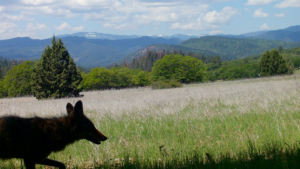Funding in place for wildlife crossing with key SOU role
(Ashland, Ore.) — A total of $37 million in federal and state funding has been secured to build a wildlife crossing over Interstate 5 south of Ashland, in a project that Southern Oregon University faculty and students have supported by monitoring wildlife patterns in the area.
Oregon recently was awarded a federal grant of $33.2 million from the U.S. Department of Transportation for the project – the first wildlife overcrossing in Oregon or anywhere on I-5, from Mexico to Canada. The Oregon Department of Transportation will match the federal funding with $3.8 million, for a total project cost of $37 million.
The overpass – whose construction is expected to begin in early 2028 – will span the freeway’s northbound and southbound lanes 1.7 miles north of the Oregon-California state line to help reduce vehicle-wildlife collisions. Its site is within the Mariposa Preserve of the Cascade-Siskiyou National Monument.
 SOU associate professor Karen Mager and her students have used camera traps to study wildlife use of I-5 for the past three years to better understand regional needs for wildlife crossings. Their data was a key component of the feasibility study that identified Mariposa Preserve as the priority site for an overpass. They provided species use data for the state and federal funding applications. and their monitoring efforts are expected to continue during and after construction of the crossing.
SOU associate professor Karen Mager and her students have used camera traps to study wildlife use of I-5 for the past three years to better understand regional needs for wildlife crossings. Their data was a key component of the feasibility study that identified Mariposa Preserve as the priority site for an overpass. They provided species use data for the state and federal funding applications. and their monitoring efforts are expected to continue during and after construction of the crossing.
“My SOU students have captured over 12,000 unique observations of the wildlife inhabiting this highway corridor,” said Mager, who serves in SOU’s Environmental Science, Policy & Sustainability and Biology departments, and is a fellow in the university’s Institute for Applied Sustainability.
“Our research confirms the extraordinary animal biodiversity at the site where this wildlife crossing will be built,” she said.
Thirteen SOU undergraduate research assistants and four undergraduate capstone projects have contributed much of the data for the project.

Karen Mager, who is leading SOU’s efforts at the wildlife crossing
“Students do fieldwork and then go through the images to identify species,” Mager said. “Incredibly, it took over 1 million photos and videos – mostly triggered by wind – to capture 12,000 animal images. SOU assistant professor of Computer Science, Bernie Boscoe, and her students worked with us to use AI to detect animals in all those images.”
The crossing will benefit the many SOU students who will continue to gain hands-on research experience by studying its impacts, Mager said. The monitoring efforts will help to document the crossing’s effects on animals and motorists.
About 6,000 vehicle-wildlife collisions are reported each year throughout Oregon, according to state agencies. The average cost of damages in a deer collision is $9,000, and it’s $24,000 for each collision with an elk, according to ODOT. Data from six wildlife underpasses in Oregon – five under Highway 97 and one under Highway 20 – show that their construction led to an 86% decrease in wildlife-vehicle collisions in those areas.
The site of the I-5 overpass is considered to be the highest-priority location along I-5, due to its biodiversity and sensitive wildlife populations, and its promise for improving animal movement through one of the only mountain corridors that connects the coast ranges to the interior Cascades. The Cascade–Siskiyou National Monument is home to rare mammals such as the Pacific fisher, along with deer, bear, elk, cougars and other large-bodied animals – all of which have been observed by Mager at the site of the future overpass. Many rare and unique butterflies and other species are also found in the area.
ODOT is working on the project in collaboration with the Southern Oregon Wildlife Crossing Coalition. A vision for the wildlife crossing grew out of a February 2021 meeting of representatives from 17 organizations and agencies that are part of the coalition.
“This is the Christmas present that wildlife in southern Oregon were hoping for,” said Jack Williams, an emeritus senior scientist for Trout Unlimited and co-coordinator of the Southern Oregon Wildlife Crossing Coalition.
“The Mariposa Wildlife Overcrossing is exactly what wildlife need – it helps to heal and restore critical east-west habitat connections that were lost when Interstate 5 was built more than 50 years ago,” Williams said.
The state and federal funding will pay for directional fencing to funnel wildlife to the overpass and associated habitat improvements, along with construction costs of the overpass itself. Some lane closures are expected along I-5 during the construction.
“While I-5 is a vital transportation corridor for our region and state, it divides the Cascade-Siskiyou National Monument, obligating wildlife to make death-defying treks across high-speed traffic,” said Oregon State Rep. Pam Marsh, whose district in the House of Representatives covers southern Jackson County. “This location will reconnect habitat and support biodiversity, while reducing wildlife-vehicle collisions. I can hardly wait for the time that bears, mountain lions and deer are safely traversing well above the freeway.”
The federal portion of the construction funding is through the Department of Transportation’s Federal Highways Administration Wildlife Crossings Pilot Program, which in turn is funded by the Inflation Reduction Act of 2022. Oregon’s U.S. senators, Jeff Merkley and Ron Wyden, pushed for that piece of the funding, along with an earlier $400,000 appropriation that helped pay for the design and engineering phases of the project.
-SOU-



